To create a thriving Mediterranean garden, I’ve found a few key conditions essential. Start with well-drained soil and guarantee it has a pH of 6.0 to 7.5. Opt for low-water plants, and water them deeply but infrequently. Place them in full sun for at least 6-8 hours daily. Regularly check for pests and maintain healthy routines. Mulching helps retain moisture too. By following these steps, you’ll enjoy a vibrant garden for years to come. There’s much more to explore!
Key Takeaways
- Ensure well-drained, slightly alkaline soil (pH 6.0 to 7.5) to prevent root rot and support healthy growth.
- Assess and tailor watering needs based on plant species, emphasizing deep, infrequent watering for drought resilience.
- Select plants suited for hot, dry summers and mild, wet winters to thrive in Mediterranean climates.
- Group plants with similar sunlight and water requirements to enhance health and create a cohesive landscape.
- Regularly monitor and maintain plant health through pruning, mulching, and pest management for a thriving garden.
Dry Climate Gardening: Growing Sustainable Gardens in Low-Water Conditions
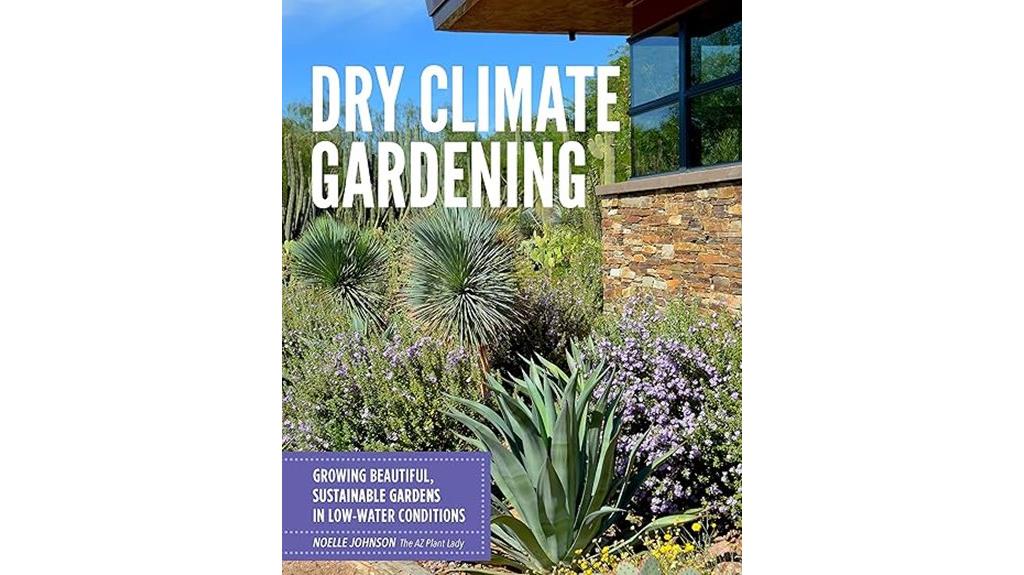
If you’re looking to create a sustainable garden in a dry climate, “Dry Climate Gardening” by Noelle Johnson is the perfect resource for you. This book offers a wealth of practical tips for thriving in low-water conditions. I found its organized layout and stunning photographs incredibly helpful when I shifted to desert gardening. Johnson’s insights on plant selection and irrigation strategies transformed my high-maintenance yard into a vibrant xeriscape. Her accessible writing style makes it easy to embrace the unique challenges of dry climates, turning them into opportunities for creativity and enjoyment in your garden. You’ll love it!
Best For: Gardeners transitioning to desert climates who want to create sustainable, low-water gardens.
Pros:
- Comprehensive guidance on plant selection, irrigation, and garden design tailored for dry climates.
- Stunning visuals that inspire creativity and help in visualizing potential garden layouts.
- Accessible writing style makes the information easy to understand and implement for beginners.
Cons:
- May not cover specific local conditions or challenges unique to every desert region.
- Some advanced gardeners might find the content too basic or not detailed enough for complex projects.
- Focused primarily on xeriscaping, which may not appeal to those interested in traditional gardening methods.
More Mediterranean: 225+ New Plant-Forward Recipes

“More Mediterranean: 225+ New Plant-Forward Recipes” is perfect for anyone enthusiastic to embrace a healthier lifestyle without sacrificing flavor. I love how this cookbook takes traditional Mediterranean dishes and gives them a fresh, plant-forward twist. The easy-to-follow instructions make cooking a breeze, no matter your skill level. Plus, the stunning photography truly inspires me to try new recipes. I appreciate the spiral-bound design that keeps the book open while I’m cooking. Whether you’re looking to eat healthier or reduce meat consumption, this book is a fantastic resource for delicious meals that cater to various dietary needs.
Best For: Those looking to adopt a healthier, plant-based lifestyle while enjoying flavorful Mediterranean cuisine.
Pros:
- Easy-to-follow instructions make it accessible for cooks of all skill levels.
- Beautiful photography inspires users to try new recipes and enhances the cooking experience.
- Spiral-bound design allows the book to lay flat, making it convenient to use while cooking.
Cons:
- Some users may prefer the original cookbook for its traditional recipes.
- The focus on plant-based options might not appeal to those who prefer meat-centric meals.
- Limited international cuisine representation outside of the Mediterranean focus.
Garden Plants for Mediterranean Climates

For those gardening in Mediterranean climates, choosing plants that thrive in low-water conditions is essential for success. I’ve found that exploring resources like “Plants for Mediterranean Climates” can be incredibly helpful. It features over 300 plant species, including many easy-to-grow options perfect for pot cultivation. However, I’ve noticed some readers express concern about invasive species and the lack of zone rankings. While the visuals could be improved, the writing is engaging. If you’re like me and value practical information, this guide can be a fantastic resource for creating a flourishing garden in your Mediterranean paradise.
Best For: Gardeners in Mediterranean climates looking for easy-to-grow, low-water plants to enhance their gardens.
Pros:
- Provides detailed descriptions of over 300 plant species, including options for pot cultivation.
- Engaging writing style that makes the information accessible and enjoyable to read.
- Includes helpful indices like “Plants for a Purpose” and “English Common Names” for easy navigation.
Cons:
- Contains invasive species that may cause ecological damage in certain areas.
- Lacks emphasis on frost and heat tolerance, as well as USDA and Sunset zone rankings.
- Visual quality of some photos is subpar, with small and out-of-focus images.
Succulent Container Gardens: Design Eye-Catching Displays with Easy-Care Plants
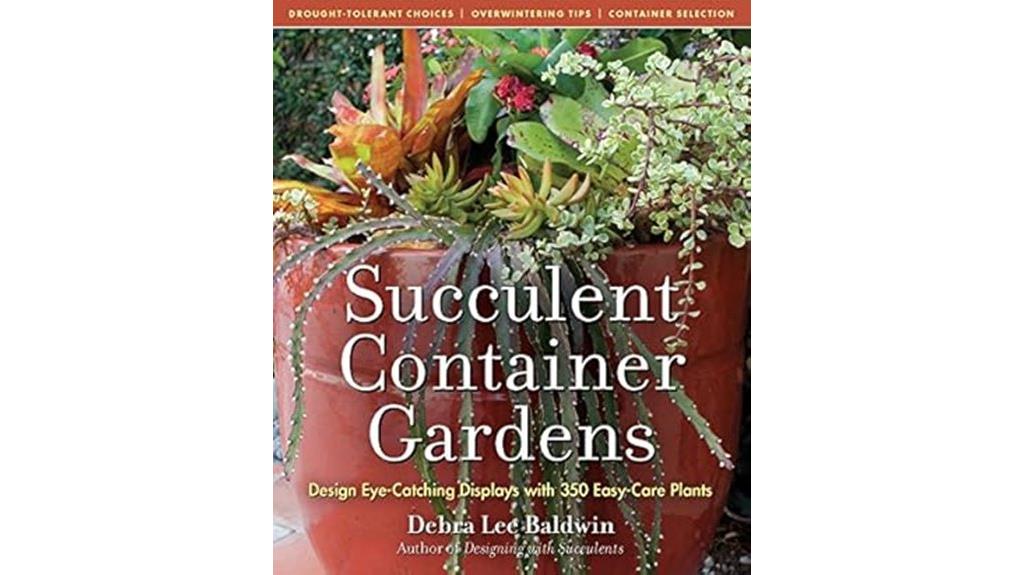
Creating a succulent container garden is an ideal choice for anyone looking to add vibrant, low-maintenance greenery to their space. I love how Susan Raynor’s book, “Succulent Container Gardens,” guides you through selecting the right plants and containers. With stunning photographs and practical tips, it makes designing your own eye-catching displays easy, even for beginners. I’ve learned to be cautious of overwatering, as these resilient plants thrive on minimal care. Whether indoors or outdoors, the creative arrangements inspired by this book can transform any area into a lush oasis. I highly recommend it for both seasoned gardeners and novices alike!
Best For: Gardening enthusiasts of all skill levels looking to create stunning succulent displays with easy-care plants.
Pros:
- Comprehensive guidance on selecting plants and containers, making it accessible for both beginners and seasoned gardeners.
- Stunning photography that serves as inspiration for designing vibrant indoor and outdoor gardens.
- Practical care instructions emphasize low maintenance and resilience, helping prevent common issues like overwatering.
Cons:
- Some critiques mention concerns about the cover quality of the book.
- Limited focus on specific climate conditions outside of Southern California may not cater to all gardeners.
- A few readers may find the information too basic if they are already experienced in succulent gardening.
Mediterranean Cooking for Diabetics

Looking to embrace a healthier lifestyle while managing diabetes? “Mediterranean Cooking for Diabetics” by Robin Ellis might just be the perfect choice for you. This cookbook is packed with simple, delicious recipes that highlight fresh ingredients and the Mediterranean diet’s health benefits. I love dishes like Pork Chops with White Beans and Blackened Salmon with Orange Yogurt Sauce. The beautiful photographs make cooking even more enjoyable! While some users wish for nutritional info, the variety and ease of preparation make it a fantastic resource for anyone wanting to cook healthier meals. You’ll find yourself loving each bite while staying mindful of your health.
Best For: Individuals looking to manage diabetes while enjoying flavorful and healthy Mediterranean cuisine.
Pros:
- Variety of recipes that cater to different tastes, including meat, fish, and vegetarian options.
- Emphasis on fresh ingredients and simplicity, making it approachable for home cooks of all skill levels.
- Beautiful full-color photographs that enhance the cooking experience and inspire creativity in the kitchen.
Cons:
- Lack of nutritional information, such as carb and fiber counts, which is crucial for diabetics.
- Some users report physical condition issues with the book upon arrival.
- Certain ingredients may seem surprising or questionable for those strictly managing their diabetes.
Designing and Creating a Mediterranean Garden
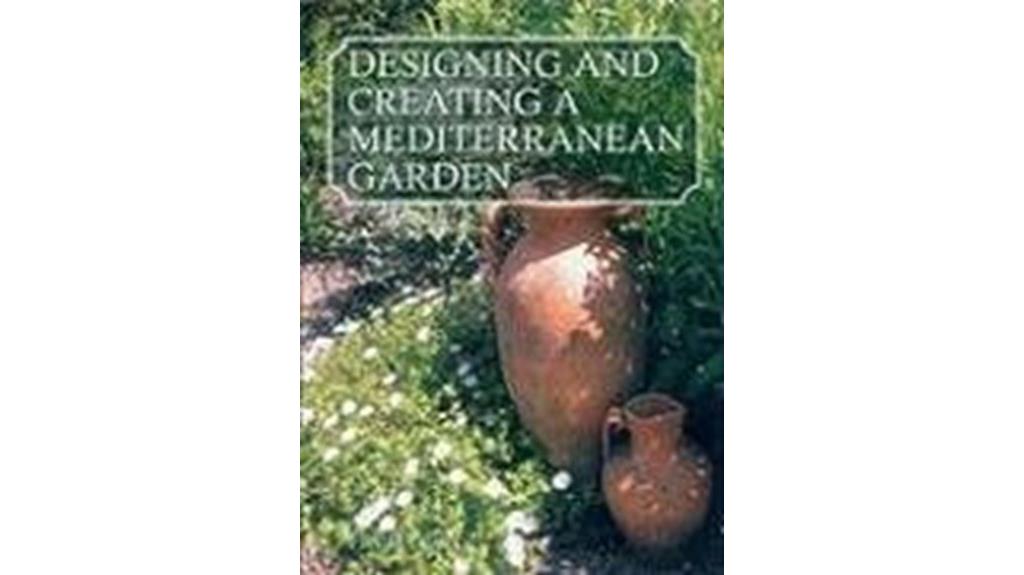
Designing a Mediterranean garden can be a rewarding endeavor for both novice and experienced gardeners seeking to bring a taste of sun-drenched landscapes into their own backyards. I found “Designing and Creating a Mediterranean Garden” by Freda Cox particularly helpful. It provides adaptable ideas for northern climates, covering essential design elements and plant requirements. While some illustrations may not capture the true Mediterranean essence, the practical guidance on plant groupings and planting instructions is invaluable. I recommend exploring this book alongside others for a well-rounded understanding of Mediterranean gardening, ensuring your garden flourishes with vibrant, sun-loving plants.
Best For: Gardeners looking to design Mediterranean-inspired landscapes in northern climates.
Pros:
- Provides practical guidance on plant groupings and planting instructions adaptable to various conditions.
- Suitable for both novice and master gardeners, making it accessible to a wide audience.
- Features colorful illustrations that enhance the instructional content.
Cons:
- Some illustrations may not adequately represent genuine Mediterranean gardens, affecting visual appeal.
- Mixed reviews regarding the authenticity of the Mediterranean theme in the visuals.
- Other titles may offer more comprehensive insights into Mediterranean gardening.
Mediterranean Cookbook for Lowering Cholesterol
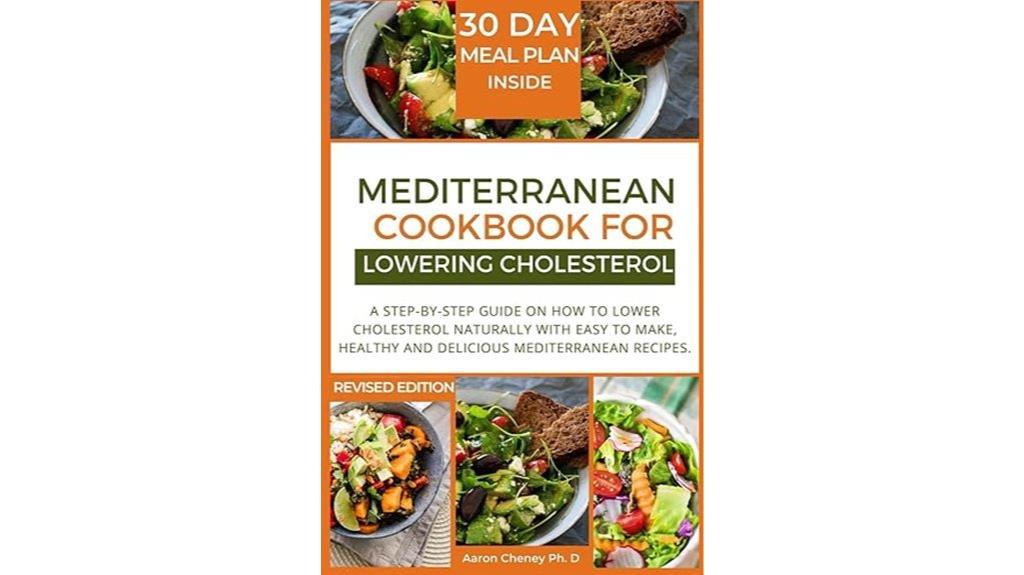
For anyone seeking to lower their cholesterol naturally while enjoying delicious meals, the Mediterranean Cookbook for Lowering Cholesterol is an excellent resource. It highlights the Mediterranean diet and encourages avoiding red meat, processed foods, and white bread, while suggesting healthier options like whole grain pasta. The cookbook offers structured recipes with serving sizes and nutritional info, making meal planning easier. However, it does have significant drawbacks, including confusing overview pages and incomplete recipes that can lead to frustration. While it has potential benefits, I can’t fully recommend it due to these content issues.
Best For: Individuals looking to lower their cholesterol naturally while adopting a Mediterranean diet.
Pros:
- Provides a structured approach with serving sizes and nutritional information for easy meal planning.
- Emphasizes healthier food alternatives, promoting whole grains and fresh ingredients.
- Aims to simplify the transition to healthier eating, particularly for beginners.
Cons:
- Contains confusing overview pages that may hinder understanding of the diet.
- Includes incomplete recipes and references to missing or incorrect pages, causing frustration.
- Overall content issues limit its effectiveness as a comprehensive guide.
Mediterranean Gardener

As someone passionate about cultivating a garden that flourishes in a Mediterranean climate, I can confidently say that “The Mediterranean Gardener” is an indispensable resource. This book offers a thorough overview of plants suited for our environment, neatly categorized into sections like trees, shrubs, and succulents. I’ve found it inspiring, transforming my own garden into a Mediterranean haven. The practical tips on soil, water management, and design are invaluable. While some may say it lacks clarity compared to other guides, I believe its wealth of information makes it a must-have for anyone ready to embrace Mediterranean gardening.
Best For: Gardeners looking to cultivate plants in Mediterranean climates and seeking inspiration for their garden design.
Pros:
- Offers a comprehensive overview of various plants suitable for Mediterranean environments, organized into clear sections.
- Provides practical information on garden design, soil, water management, and maintenance practices.
- Inspires readers with visual elements and personal gardening experiences that encourage creativity in garden transformation.
Cons:
- Some readers find it less focused and harder to follow compared to other gardening resources.
- The book may lack flow and clarity, which could hinder the overall reading experience for some.
- Finding the book can be challenging, limiting its accessibility for interested gardeners.
Mediterranean Diet Cookbook for Two 2024
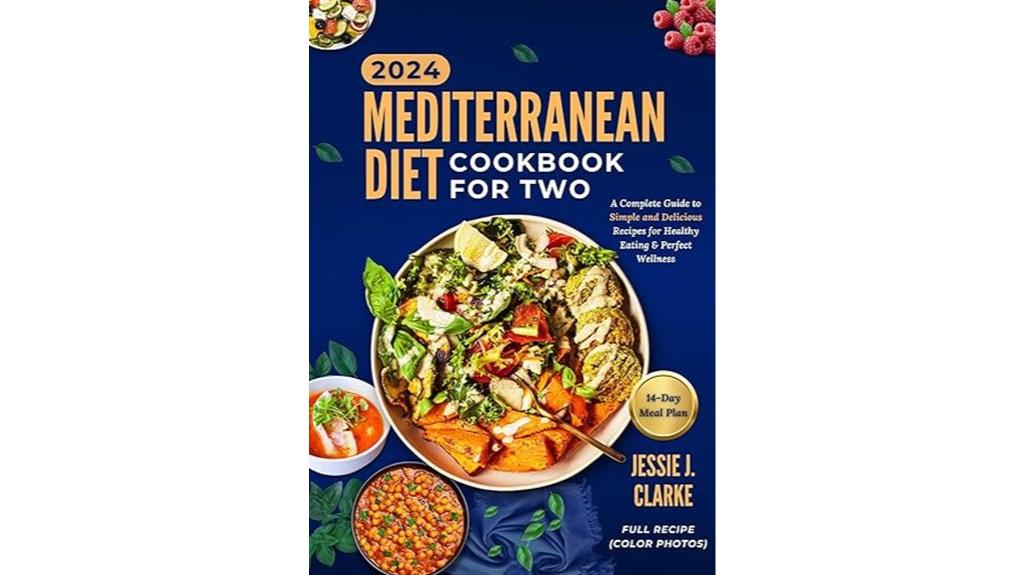
If you’re looking to embrace a healthier lifestyle with your partner, the “Mediterranean Diet Cookbook for Two 2024” is an ideal choice. This all-encompassing guide offers over 50 simple and delicious recipes, perfect for beginners like us. From breakfast to dinner, it covers everything—soups, salads, desserts, snacks, and smoothies. Each recipe comes with full-color pictures that inspire and enhance our cooking experience. I’ve found it user-friendly and engaging, making it easy to explore this vibrant diet. I highly recommend this cookbook if you want to enjoy culinary bliss while adopting healthier eating habits together.
Best For: Couples looking to adopt a healthier lifestyle through simple and delicious Mediterranean recipes.
Pros:
- Beginner-friendly approach makes it accessible for those new to cooking or the Mediterranean diet.
- Diverse recipe variety includes options for all meals, snacks, and desserts, catering to different tastes and preferences.
- Full-color pictures accompany each recipe, providing visual inspiration and enhancing the cooking experience.
Cons:
- May not include advanced or complex recipes for more experienced cooks seeking culinary challenges.
- Limited to recipes for two, which may not be suitable for larger households or gatherings.
- Some ingredients may be less accessible depending on location, potentially complicating meal preparation.
Mediterranean Diet for Cancer Book

Designed specifically for individuals who may feel overwhelmed by nutritional information, the “Mediterranean Diet for Cancer” book serves as an excellent starting point for anyone seeking straightforward dietary guidance. It’s perfect for those with limited nutritional knowledge or chronic ailments. The book offers concise information on foods that help with cancer prevention and treatment, along with a list of foods to avoid for better health. I appreciate the easy recipes it includes, making it practical for beginners. I highly recommend this book; it’s so useful that I’m considering getting an extra copy for my home reference.
Best For: Individuals with limited nutritional knowledge or chronic ailments seeking straightforward dietary guidance for cancer prevention and treatment.
Pros:
- Provides concise and accurate information on beneficial foods for cancer prevention.
- Includes easy and appetizing recipes that are practical for beginners.
- Offers insights into the overall health benefits of the Mediterranean diet beyond cancer.
Cons:
- May lack in-depth detail for readers seeking comprehensive nutritional information.
- The effectiveness of recipes has not been personally trialed yet.
- Limited to cancer-related dietary guidance, which may not appeal to those looking for broader nutrition advice.
Factors to Consider When Choosing Mediterranean Plant Conditions
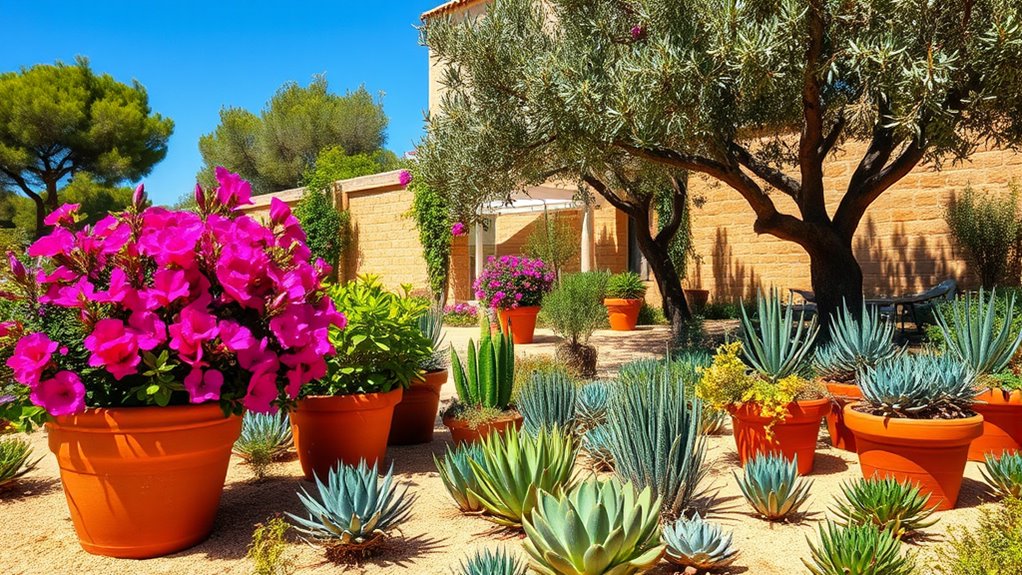
When I think about creating the perfect Mediterranean garden, I focus on several key factors. The right soil type, climate adaptability, and proper watering are essential to guarantee my plants thrive. Plus, considering sunlight exposure and plant compatibility can make all the difference in achieving a lush, vibrant garden.
Soil Type Importance
Soil type is the backbone of a successful Mediterranean garden, directly affecting how well your plants thrive. I’ve found that well-drained soils, like sandy or loamy types, are vital. They prevent waterlogging and root rot, both of which can be detrimental to drought-tolerant species. It’s also important to take into account soil pH; many Mediterranean plants prefer slightly alkaline to neutral soils (pH 6.0 to 7.5) for ideal nutrient uptake. Adding organic matter, such as compost, can enhance soil structure and fertility, especially if your garden’s initial conditions are poor. Regular soil testing is a game-changer, helping you understand nutrient levels and pH, so you can make the necessary amendments for a thriving Mediterranean garden.
Climate Adaptability Factors
Understanding climate adaptability factors is crucial for creating a thriving Mediterranean garden. These plants flourish in regions with hot, dry summers and mild, wet winters, so I carefully select varieties that suit these conditions. Drought tolerance is imperative; many Mediterranean plants have adapted to survive long periods without water, making them perfect for low-water landscapes. I also pay attention to soil conditions, ensuring it’s well-drained to mimic their natural rocky habitats. Heat tolerance is another key aspect; I choose plants that can withstand temperatures over 90°F (32°C) during the peak of summer. Finally, I consider microclimates in my garden, as they can greatly influence plant performance based on factors like sun exposure and wind patterns.
Watering Requirements Assessment
To guarantee my Mediterranean garden thrives, I carefully assess the watering requirements of each plant. These plants typically have low water needs, making them perfect for arid climates. I’ve learned that many Mediterranean species thrive on just 15-30 inches of water annually. It’s essential to evaluate the drainage and soil moisture retention in my garden, as well-draining soils prevent root rot. I water deeply but infrequently, allowing the soil to dry out between sessions to mimic natural conditions. Understanding the specific needs of each species is critical; some require extra water during establishment, while others are highly drought-tolerant once settled. This tailored approach guarantees my garden remains vibrant and healthy.
Sunlight Exposure Needs
While planning my Mediterranean garden, I quickly realized that sunlight exposure is essential for my plants’ success. Most Mediterranean plants thrive in full sun, needing at least 6 to 8 hours of direct sunlight daily. They’re adapted to handle intense sunlight and heat, which makes them perfect for bright, dry conditions. I found that insufficient sunlight can lead to weak growth and fewer flowers, plus it makes plants more vulnerable to pests. It’s vital to observe the angle and duration of sunlight throughout the seasons, as some plants may need repositioning. Grouping plants with similar sunlight requirements not only optimizes their health but also creates a vibrant, cohesive landscape that I can’t wait to see flourish.
Plant Compatibility Considerations
Choosing the right plants for a Mediterranean garden involves several key factors that can make or break your success. First, I always look for drought-tolerant species since they thrive in low-water conditions. Next, I consider the soil type; well-draining soil is essential to prevent root rot, so I often amend heavy soils. Sun exposure is another critical factor; most Mediterranean plants need at least six hours of direct sunlight daily to flourish. Additionally, I check temperature tolerance to guarantee plants can handle the region’s heat and occasional frost. Finally, I think about plant compatibility with local wildlife and avoid invasive species that could disrupt the ecosystem. Keeping these factors in mind helps create a vibrant, sustainable garden.
Frequently Asked Questions
What Pests Are Common in Mediterranean Gardens?
When I tend to my Mediterranean garden, I often encounter a few common pests. Aphids seem to love my plants, and I’ve noticed spider mites creeping in during the dry spells. Whiteflies can be a real nuisance too. I’ve learned that keeping an eye out for these pests is essential. Regularly checking my plants helps me catch infestations early, ensuring my garden stays healthy and vibrant. What’s your experience with these pesky visitors?
How Often Should I Water Mediterranean Plants?
Watering Mediterranean plants feels like conducting a symphony; each note must harmonize with the others. I usually water them deeply but infrequently, about once a week, allowing the soil to dry out between sessions. During hotter months, I might increase that to twice a week. Always check the soil moisture first—overwatering can lead to trouble. Listening to your plants will guide you to their perfect rhythm!
Can I Grow Mediterranean Plants Indoors?
Absolutely, you can grow Mediterranean plants indoors! I’ve had great success with varieties like rosemary and thyme. Just make certain you place them in a sunny spot, ideally near a south-facing window. I also guarantee they have well-draining soil and don’t overwater them. It’s all about mimicking their natural environment. With a little care and attention, you’ll enjoy the beauty and aroma of Mediterranean plants right in your home!
What Soil Type Is Best for Mediterranean Gardening?
Did you know that about 40% of the world’s plant species thrive in Mediterranean climates? When it comes to soil for Mediterranean gardening, I’ve found that well-draining soil is vital. I usually mix sand, perlite, and organic matter to create a perfect blend. This combination guarantees that water drains quickly, preventing root rot while still retaining enough moisture for my plants. So, focus on that drainage, and you’ll see great results!
Are There Mediterranean Plants That Attract Pollinators?
Absolutely, there are many Mediterranean plants that attract pollinators! I’ve found that lavender, rosemary, and thyme are not only beautiful but also draw in bees and butterflies. Each time I walk through my garden, I see these pollinators buzzing around these plants, which adds life and vibrancy. If you want to create a pollinator-friendly space, consider incorporating these plants. They thrive in sunny spots and need minimal water, making them perfect for my garden!
Conclusion
In the grand tapestry of gardening, embracing Mediterranean conditions can transform your outdoor space into a vibrant oasis. By understanding the delicate dance between sun and soil, you’ll not only cultivate beauty but also nurture the soul. Remember, every plant tells a story—one of resilience and adaptability. So, let’s raise a glass to our green companions, celebrating their journey and ours. Here’s to a flourishing garden that thrives under the sun’s warm embrace!









